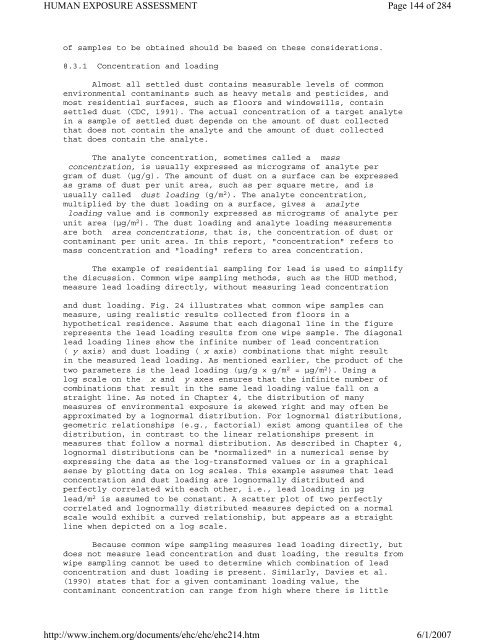Environmental Health Criteria 214
Environmental Health Criteria 214
Environmental Health Criteria 214
Create successful ePaper yourself
Turn your PDF publications into a flip-book with our unique Google optimized e-Paper software.
HUMAN EXPOSURE ASSESSMENT<br />
of samples to be obtained should be based on these considerations.<br />
8.3.1 Concentration and loading<br />
Almost all settled dust contains measurable levels of common<br />
environmental contaminants such as heavy metals and pesticides, and<br />
most residential surfaces, such as floors and windowsills, contain<br />
settled dust (CDC, 1991). The actual concentration of a target analyte<br />
in a sample of settled dust depends on the amount of dust collected<br />
that does not contain the analyte and the amount of dust collected<br />
that does contain the analyte.<br />
The analyte concentration, sometimes called a mass<br />
concentration, is usually expressed as micrograms of analyte per<br />
gram of dust (µg/g). The amount of dust on a surface can be expressed<br />
as grams of dust per unit area, such as per square metre, and is<br />
usually called dust loading (g/m 2 ). The analyte concentration,<br />
multiplied by the dust loading on a surface, gives a analyte<br />
loading value and is commonly expressed as micrograms of analyte per<br />
unit area (µg/m 2 ). The dust loading and analyte loading measurements<br />
are both area concentrations, that is, the concentration of dust or<br />
contaminant per unit area. In this report, "concentration" refers to<br />
mass concentration and "loading" refers to area concentration.<br />
The example of residential sampling for lead is used to simplify<br />
the discussion. Common wipe sampling methods, such as the HUD method,<br />
measure lead loading directly, without measuring lead concentration<br />
and dust loading. Fig. 24 illustrates what common wipe samples can<br />
measure, using realistic results collected from floors in a<br />
hypothetical residence. Assume that each diagonal line in the figure<br />
represents the lead loading results from one wipe sample. The diagonal<br />
lead loading lines show the infinite number of lead concentration<br />
( y axis) and dust loading ( x axis) combinations that might result<br />
in the measured lead loading. As mentioned earlier, the product of the<br />
two parameters is the lead loading (µg/g × g/m 2 = µg/m 2 ). Using a<br />
log scale on the x and y axes ensures that the infinite number of<br />
combinations that result in the same lead loading value fall on a<br />
straight line. As noted in Chapter 4, the distribution of many<br />
measures of environmental exposure is skewed right and may often be<br />
approximated by a lognormal distribution. For lognormal distributions,<br />
geometric relationships (e.g., factorial) exist among quantiles of the<br />
distribution, in contrast to the linear relationships present in<br />
measures that follow a normal distribution. As described in Chapter 4,<br />
lognormal distributions can be "normalized" in a numerical sense by<br />
expressing the data as the log-transformed values or in a graphical<br />
sense by plotting data on log scales. This example assumes that lead<br />
concentration and dust loading are lognormally distributed and<br />
perfectly correlated with each other, i.e., lead loading in µg<br />
lead/m 2 is assumed to be constant. A scatter plot of two perfectly<br />
correlated and lognormally distributed measures depicted on a normal<br />
scale would exhibit a curved relationship, but appears as a straight<br />
line when depicted on a log scale.<br />
Because common wipe sampling measures lead loading directly, but<br />
does not measure lead concentration and dust loading, the results from<br />
wipe sampling cannot be used to determine which combination of lead<br />
concentration and dust loading is present. Similarly, Davies et al.<br />
(1990) states that for a given contaminant loading value, the<br />
contaminant concentration can range from high where there is little<br />
http://www.inchem.org/documents/ehc/ehc/ehc<strong>214</strong>.htm<br />
Page 144 of 284<br />
6/1/2007

















